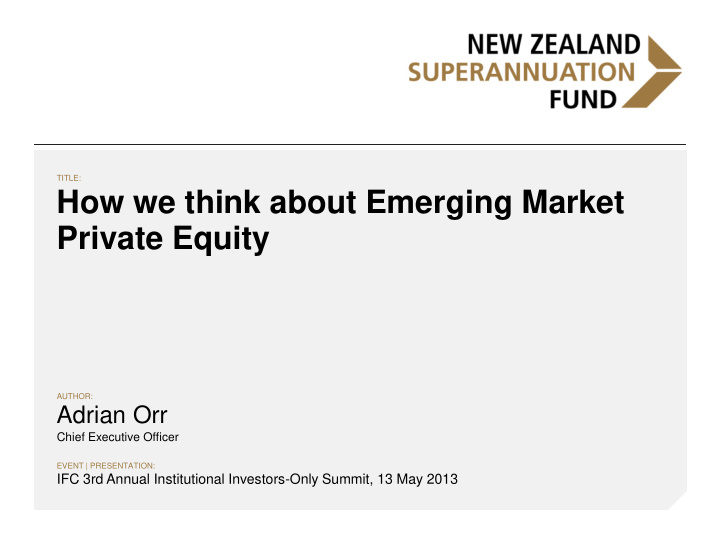



TITLE: How we think about Emerging Market Private Equity AUTHOR: Adrian Orr Chief Executive Officer EVENT | PRESENTATION: IFC 3rd Annual Institutional Investors-Only Summit, 13 May 2013
SUPERDOCS REF 859991 \ PG 2 Our Investment Framework: Being Opportunistic Attractiveness Opportunities where link between our endowments and beliefs, and the investment Confidence Access opportunities as directly as possible Consistent with our target operating model Develop investment Maintain internal Access external themes investment managers to opportunity ‘partner’ with identification and implementation skills • and
SUPERDOCS REF 859991 \ PG 3 How we do it: Opportunity then Access Actual Portfolio as at 31/01/13 Reference Portfolio Global equities 61% Fixed income 9% Global equities 70% Infrastructure 8% Timber 6% Fixed interest 20% Property 6% NZ equities 5% Global listed property Other private markets 2% 5% Private equity 2% NZ equities 5% Rural farmland 1% Reference Value Adding Actual Portfolio Portfolio Activities Active investment Portfolio Completion Strategic strategies tilting Our Investment Beliefs
SUPERDOCS REF 859991 \ PG 4 Where can Emerging Market Private Equity Fit? Global Economic Global Portfolio Reference Investable Portfolio A B C Portfolio Emerging market investments across A, B, C A = Passive, listed, liquid B = A + Active Decisions and Tilting (e.g., Private equity) C = A + B + Active Decisions (e.g., direct investing)
SUPERDOCS REF 852646 \ PG 5 Reference Portfolio – Underweight Emerging market? Traditional market cap weightings under value Emerging Market New Emerging Market listed indices available – debt, equity, and FX Sound rationale for including EM and Frontier Market indices on investment grounds • Higher risk premiums • More diversified – country specific drivers, demographics, segmentation • Better matches economic exposure of Global Portfolio • Be aware of economic versus risk versus asset class exposure from outset
SUPERDOCS REF 859991 \ PG 6 Actual Portfolio and role of Emerging market Exposure Actual portfolio = Passive (reference) + Active Active investments only if ‘Excess Returns’ available ‘Excess’ Returns in Emerging market / Frontier market? Mis-pricing long-run returns Segmentation in markets Risk premia convergence Higher productivity mis-priced Diversification Less Competition Each potential driver of ‘excess returns’ has significant pros and cons to be considered
SUPERDOCS REF 859991 \ PG 7 Excess Returns in Emerging Markets? Prima facie good grounds to be optimistic…..but devil in the detail: • Economic exposure vs asset class exposure – how much is enough? • Proof of ‘excess returns’ e.g. • Home bias, returns to capital, degree of diversification, ESG issues • Best relative ‘excess return’ • Best access points • Overweight beta? • Targeted countries, market segmentation via direct or PE? Private Equity is one ‘access point’ but needs to be related to specific opportunity
SUPERDOCS REF 859991 \ PG 8 Summary Passive Reference Portfolio exposure underweighted Emerging / Frontier Prima facie case for ‘excess returns’ is strong, but ‘devil in detail’ Private Equity is an access point however not an opportunity Private Equity may be a very good access point in Emerging / Frontier markets due to • Search costs • Principal agent risks • Risk sharing • Targeted nature of returns
Recommend
More recommend